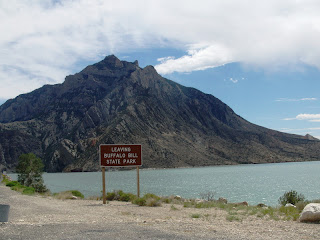22nd July 2012 - Yellowstone NP to Cody, Wyoming
We left the Grizzly Bear RV Park on a beautiful Sunday morning and headed east to Cody, Wyoming. On this outgoing trip, the elevation would probably be about 8- 9000 ft above sea level - our truck does its job nicely as its a turbo diesel.
To get to Cody, we had to enter YNP once again and depart via the East Entrance. We saw herds of bisons again - what a treat!
Lake Butte - what a beautiful lake, especially with the reflections of sky and land captured on its mirror like surface.
Further along US 16/14 is Lake Sylvan - even here there are hot springs along its shores. Check out the pic below.
We had a coffee break at Steamboat Point, Lake Sylvan-rather aptly named. Most disappointing to see the numerous spent cigarette butts strewn along the scenic pull in.
As we ascended further, the landscape changes quite dramatically - we passed through forests of burnt trees with new growth. A bit of background to the great fire of 1988 follows.
The Yellowstone fires of 1988 together formed the largest wildfire in the recorded history of the U.S.'s Yellowstone National Park. Starting as many smaller individual fires, the flames spread quickly out of control with increasing winds and drought and combined into one large conflagration, which burned for several months. The fires almost destroyed two major visitor destinations and, on September 8, 1988, the entire park was closed to all non-emergency personnel for the first time in its history.[1] Only the arrival of cool and moist weather in the late autumn brought the fires to an end. A total of 793,880 acres (3,213 km2), or 36 percent of the park was affected by the wildfires.[2]
Thousands of firefighters fought the fires, assisted by dozens of helicopters and fixed-wing aircraft which were used for water and fire retardant drops. At the peak of the effort, over 9,000 firefighters were assigned to the park. With fires raging throughout the Greater Yellowstone Ecosystem and other areas in the western United States, the staffing levels of the National Park Service and other land management agencies were inadequate to the situation. Over 4,000 U.S. military personnel were soon assisting in fire suppression efforts. The fire fighting effort cost $120 million ($240 million as of 2012). No firefighters died while fighting the fires in Yellowstone, though there were two fire-related deaths outside the park.
It is 30deg. celsius but there were still sprinklings of snow on the mountains.
The Shoshone River winding its way into Cody - can you see the fisherman on the river bank?
The landscape is quite similar to that found in Bryce and Zion National Parks.
This derelict building caught our eyes - haven't a clue what it used to be.
Another change to the scenery as we approach the Buffalo Bill dam
The mountains are a mix of coral and sandstone colours.
Al and truck at carpark of Buffalo Bill DamVisitor Centre.
The Buffalo Bill Dam - at this pull in, you can visit the workings of the dam. There is a shuttle (golf cart) that will come and pick up visitors every 30 mins and take them to the main building.
Entering Cody, named after William F. Cody aka Buffalo Bill Cody.




















Pretty spectacular drive - I'm sure you have many more to enjoy too.
ReplyDelete